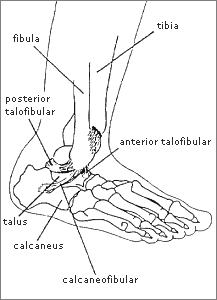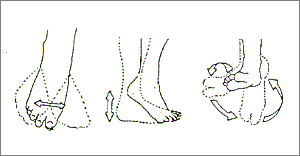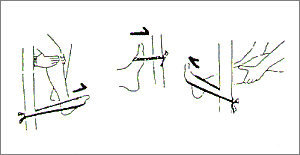Sports Medicine Education No. I - Ankle Sprain
Description
A sprained ankle is an acute injury that involves damage to the ligaments of the ankle. It is especially common in jumping sports. The ankle joint is formed by the tibia, the fibula, the talus and the calcaneus.
On the inside of the ankle, the joint is stabilised by the deltoid ligament. Sprain to this ligament is less common. On the outside of the ankle, the joint is stabilised by 3 ligaments, the anterior talofibular ligament, the calcaneofibular ligament and the posterior talofibular ligament. Sprain to these ligaments accounts for more than 80% of all ankle sprains.
If the ankle is treated quickly and properly, it should heal well and allow a safe and early return to sport. Inadequate rehabilitation may lead to persistent pain, loss of function, joint instability and recurrent injury. A lot of athletes think that their ankles have completely recovered as soon as pain has subsided. This is in fact very wrong!

Pathology
Sprains can be classified into degrees of injury.
| Degree | Extent | Prognosis |
| 1st | - Mild tearing and stretching of ligament - Mild swelling if any - No instability |
Return to sport 3 days to 2-3 weeks. |
| 2nd | - Partially torn ligaments - Involves injury to 1 or more of the ligaments - Swelling and bruising |
3-6 weeks before return to sport. |
| 3rd | - Complete rupture of 2 or more ligaments - May involve a fracture - Swelling, bruising - Pain on opposite side of sprain due to compression of tissue and bone |
Can be 8-12 months for ligaments to fully heal. |
Contributing Factors
- Previous injury
- Compensation for other injury
- Unsuitable/worn out shoes
- Weak ankle muscles (especially evertors)
- Tight Achilles Tendon
- Uneven ground
Treatment
Please consult your doctor/physiotherapist before starting the following treatment.
- R.I.C.E. for 48 hours:
Rest: from aggravating activities
Ice: for 15-20 minutes every 2 hours
Compression: with elastic bandage
Elevation: using pillows, elevate above level of the hip - Anti-inflammatory medication may be prescribed
- Continuing care:
I)
Physiotherapy
Treatment may include the use of manual techniques and electrical equipments e.g. ultrasound, interferential etc.II)
Mobilisation
Mobilisation can commence immediately within a pain-free range of motion. Early mobilisation can prevent excessive scarring and assist in restructuring a strong ligamenta)
Range of motion (R.O.M.) exercises, circles, up and down, in and out
Twenty times each

b) Strengthening exercises
Three sets of ten each

c) Proprioceptive exercises
Thirty seconds each, repeat three times

If you have any queries about these exercises, please consult your physiotherapist.
III)
When able to hop ten times and stand on toes of the injured ankle for 20 seconds, progress to next step. Jogging in straight line, gradually progressing to "s" jogging or large "8's" and eventually to cuts, zigzags, stops and starts. When the zigzags can be done pain-free without support, athletes can return to sports.
Return to sports
Some protection is needed for the ankle for at least 6 months, as remodelling of the ligament is not complete until then.
Taping is the best, and supports or braces are an option.
For more information, please contact:
Sports Medicine Unit
Telephone(852) 2681 6134
All information in this pamphlet is for reference only
 ID: hksportsinstitute
ID: hksportsinstitute

